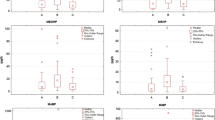Abstract
Spot urine samples were collected in summer and winter season to examine the association between temperature variation and phthalate concentration in an occupationally exposed group. We analysed samples by high-performance liquid chromatography with mass spectrometry (HPLC-MS/MS) to determine the concentrations of four phthalate metabolites: mono (2-ethylhexyl) phthalate (MEHP), monobutyl phthalate (MnBP), monoethyl phthalate (MEP), and monoisononyl phthalate (MiNP). We observed significantly higher urinary concentrations of all monitored phthalate metabolites collected during the summer in occupationally exposed group (MEP p < 0.0015, MiNP p < 0.0001, MnBP p < 0.00019, and MEHP p < 0.05); however, in general, population was noticed this difference only for MEHP (p < 0.05) in winter season. We conclude that increasing indoor and outdoor temperature is related to phthalate exposure in specific types of work environment.


Similar content being viewed by others
References
Bornehag CG, Lundgren B, Wechler CJ, Sigsgaard T, Hagerhed-Engman L, Sundell J (2005) Phthalates in indoor dust and their association with building characteristics. Environ Health Perspect 113:1399–1404
Caserta D, Mantovani A, Marci R, Fazi A, Ciardo F, La Rocca C, Maranghi F, Moscarini M (2011) Environment and women’s reproductive health. Hum Reprod Update 17(3):418–433
CDC (2005) Third National Report on Human Exposure to Environmental Chemicals. (http://www.cdc.gov/exposurereport/3rd/pdf/thirdreport.pdf) Atlanta, GA, Centers for Disease Control and Prevention; National Center for Environmental Health; Division of Laboratory Sciences. 11-4-2007
Clausen PA, Liu Z, Kofoed-Sorensen V, Wolkoff P (2012) Influence of temperature on the emission of di-(2-ethylhexyl) phthalate (DEHP) from PVC flooring in the emission cell FLEC. Environ Sci Technol 46:909–915
Duty SM, Calafat AM, Silva MJ, Ryan L (2005) Phthalate exposure and reproductive hormones in adult men. Hum Reprod 20:604–610
Fong JP, Lee FJ, Lu IS, Uang SN, Lee CC (2014) Estimating the contribution of inhalation exposure to di-2-ethylhexyl phthalate (DEHP) for PVC production workers, using personal air sampling and urinary metabolite monitoring. Int J Hyg Environ Health 217(1):102–129
Fujii M, Shinohara N, Lim A, Otake T, Kumagai K, Yanagisawa Y (2003) A study on emission of phthalate esters from plastic materials using a passive flux sampler. Atmos Environ 37:5495–5504
Gaudin R, Marsan P, Ndaw S, Robert A, Ducos P (2011) Biological monitoring of exposure to di(2-ethylhexyl) phthalate in six French factories: a field study. Int Arch Occup Environ Health 84:523–531
Guo Y, Wu Q, Kannan K (2011) Phthalate metabolites in urine from China, and implications for human exposures. Environ Int 37(5):893–8
Hauser R, Calafat AM (2005) Phthalates and human health. Occup Environ Med 62:806–818
Heudorf M, Mersch-Sundermann V, Angerer J (2007) Phthalates: Toxicology and exposure. Int J Hyg Environ Health 210:623–634
Hines CJ, Nilsen Hopf NB, Deddens JA, Calafat AM, Silva MJ, Grote AA, Sammons DL (2009) Urinary phthalate metabolite concentrations among workers in selected industries: a pilot biomonitoring study. Ann Occup Hyg 53(1):1–17
Jaakkola JJK, Knight TL (2008) The role of exposure to phthalates from polyvinyl chloride products in the development of asthma and allergies. Environ Health Perspect 116:845–853
Jonsson BA, Richtoff J, Rylander L, Giwercman A, Haqmar L (2005) Urinary phthalate metabolites and biomarkers of reproductive function in young men. Epidemiology 16(4):487–493
Kavlock R, Boeckelheide K, Chapin R, Cunningham M, Faustman E, Foster P, Golub M, Henderson R, Hinberg I, Little R, Seed J, Shea K, Tabacova S, Tyl R, Williams P, Zacharewski T (2002) NTP Center for the Evaluation of Risks to Human Reproduction: Phthalates expert panel report on the reproductive and developmental toxicity of di(2-ethylhexyl)phthalate. Reprod Toxicol 16:529–653
Koch HM, Calafat AM (2009) Human body burdens of chemicals used in plastic manufacture. Philos Trans R Soc Lond B Biol Sci 364:2063–2078
Koch HM, Rossbach B, Drexler H, Angerer J (2003) Internal exposure of the general population to DEHP and other phthalates—Determination of secondary and primary phthalate monoester metabolites in urine. Environ Res 93:177–185
Kolarik B, Naydenov K, Larsson M, Bornehag CG, Sundell J (2008) The association between phthalates in dust and allergic diseases among Bulgarian children. Environ Health Perspect 116:98–103
Koniecki D, Wang R, Moody RP, Zhu J (2011) Phthalates in cosmetic and personal care products: Concentrations and possible dermal exposure. Environ Res 111(3):329–336
Silva M, Slakman AR, Reidy JA, Preau JR, Herbert JL, Samandar E, Needham LL, Calafat AM (2004a) Analysis of human urine for fifteen phthalate metabolites using automated solid-phase extraction. J Chromatogr B 805(2004):161–167
Silva MJ, Barr DB, Reidy JA, Malek NA (2004b) Urinary levels of seven phthalate metabolites in the US population from the National Health and Nutrition Examination Survey (NHANES) 1999–2000. Environ Health Perspect 112:331–338
Stanley MK, Robillard KA, Staples CHA (2003) Introduction. Handbook of environmental chemistry 3Q, s. 1–7
Swan SH (2008) Enviromental phthalate exposure in relation to reproductive outcomes and another health endpoints in humans. In: Environ res. 105:177–184
Wittassek M, Koch HM, Angerer J, Bruning T (2011) Assessing exposure to phthalates-The human biomonitoring approach. Mol Nutr Food Res 55:7–31
Acknowledgments
This study was supported by projects VEGA “Analysis of selected environmental factors in relation to potential health risks” (V1/0042/12) and the project implementation: “Environmental aspects of urban area” (ITMS: 26220220110) supported by the Research & Development Operational Programme funded by the ERDF. We thank Michaela Földesiova for excellent technical assistance.
Conflicts of interest
The authors declare that they have no conflict of interest.
Author information
Authors and Affiliations
Corresponding author
Additional information
Responsible editor: Hongwen Sun
Rights and permissions
About this article
Cite this article
Pilka, T., Petrovicova, I., Kolena, B. et al. Relationship between variation of seasonal temperature and extent of occupational exposure to phthalates. Environ Sci Pollut Res 22, 434–440 (2015). https://doi.org/10.1007/s11356-014-3385-7
Received:
Accepted:
Published:
Issue Date:
DOI: https://doi.org/10.1007/s11356-014-3385-7



